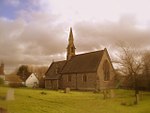Lewknor Bridge Halt railway station
1906 establishments in England1957 disestablishments in EnglandDisused railway stations in OxfordshireFormer Great Western Railway stationsPages with no open date in Infobox station ... and 3 more
Railway stations in Great Britain closed in 1957Railway stations in Great Britain opened in 1906Use British English from December 2016

Lewknor Bridge Halt railway station was a halt on the Watlington and Princes Risborough Railway which the Great Western Railway opened in 1906 to serve the Oxfordshire village of Lewknor. The opening of the halt was part of a GWR attempt to encourage more passengers on the line at a time when competition from bus services was drawing away patronage.
Excerpt from the Wikipedia article Lewknor Bridge Halt railway station (License: CC BY-SA 3.0, Authors, Images).Lewknor Bridge Halt railway station
Oakley Road, South Oxfordshire
Geographical coordinates (GPS) Address Nearby Places Show on map
Geographical coordinates (GPS)
| Latitude | Longitude |
|---|---|
| N 51.6703 ° | E -0.9665 ° |
Address
B4009/M40 Bus Link
Oakley Road
OX49 5TS South Oxfordshire
England, United Kingdom
Open on Google Maps










